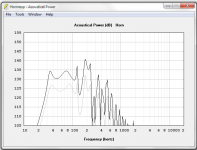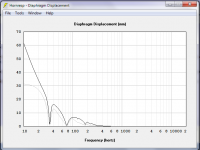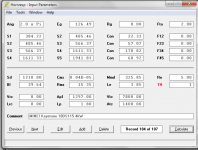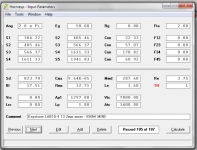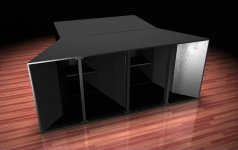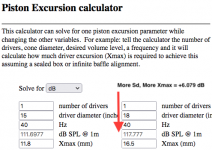Thanks Art. I forgot about the sim thing but at home now. As usual, you were correct and I am wrong. The comparison was ACTUALLY from the one I built with LAB15-4 vs B&C 18DS115. It's abut 9-10db different. That is shocking to me as my Keystone Light as I call it, is LOUD. The 18DS115 is 135db vs 126/7db for the LAB15.
Sam,I forgot about the sim thing but at home now. The comparison was ACTUALLY from the one I built with LAB15-4 vs B&C 18DS115. It's abut 9-10db different.
Can't find any specifications for an Eminence LAB15-4, only the LAB15, nominally 6 ohm with a 4.9 ohm Re.
That said, given the excursion and Sd of the two drivers, a 10dB difference in output still sounds like too much. Without seeing the simulations, can't tell whether input parameter values, excursion, voltage, or something else accounts for the disparity.
Art
Art, I will try and post. Sd x xmax = displacement? Is it really that simple to compare drivers like that? I am trying to develop some common sense with this. I will say the 18DS115 needed 4kw to hit that level.
1) Yes, Vd (Volume of displacement) is equal to Sd multiplied by Xmax.1)Sd x xmax = displacement?
2)Is it really that simple to compare drivers like that? I will say the 18DS115 needed 4kw to hit that level.
2) Knowing the Vd won't compare frequency response or the voltage sensitivity of a driver in any cabinet alignment.
A driver that won't reach Xmax without exceeding it's thermal limits in a particular design may "simply" burn up before reaching it's Vd limited output.
Richard Long’s Bertha and Levan
Bertha was the name for the W bin.
Levan was the name of the mouth extension. Named for Larry Levan DJ of the Paradise Garage in NYC. The mouth is 42H x 8 feet. There were a few 42 x 10 foot mouths ( i did a club with Richard where 2 of the 10 mouth bass horns were double stacked vertically for some very nice low end impact ). It used 2 custom Eminence 18 drivers.
Bertha was the name for the W bin.
Levan was the name of the mouth extension. Named for Larry Levan DJ of the Paradise Garage in NYC. The mouth is 42H x 8 feet. There were a few 42 x 10 foot mouths ( i did a club with Richard where 2 of the 10 mouth bass horns were double stacked vertically for some very nice low end impact ). It used 2 custom Eminence 18 drivers.
Attachments
Last edited:
Here's what I have.
Sam,
Posting Hornresp charts for a tapped horn with output that does not conform to the input parameters in a post about an “Old W bin” is a bit off topic, but most of the concepts still apply to FLH and other resonant designs..
The 18” at 16.5mm excursion compared to the 15” at 11.8mm has an increase of 6dB due to the displacement increase, as seen in the piston displacement calculator example set to the maximum excursion frequency of 40Hz.
Simulating half vs full space adds +6dB to the example, the cabinet alignment adds around +6dB level on top of of that, then gain due to additional applied voltage amounts to the differences you see in the Hornresp simulation.
The power used at each frequency is dependent on the impedance curve, which you did not post. Brian Steele (the OP) would want to see those, if you had happened to post up a ported FLH similar to the one this post was about ;^).
Assuming worst case, the impedance minima at Fb will be equal to Re (DC Resistance) of the driver.
Power in watts is equal to voltage x voltage /resistance, so the 18” draws around 3200 watts at 5 ohms, or 2000 at 8 ohms (nominal) using 126.5 volts.
The nominal power rating of 1700 watts at 8 ohms is exceeded by a fraction of a dB to near 3dB depending on the frequency- though much of the frequency range will have impedance far above the nominal or DCR.
The 15” draws around 666.66 watts at 3.75 ohms, or 625 at 4 ohms (nominal) using 50 volts, within a fraction of a dB of the nominal rating of 600 watts.
The additional output of the larger driver requires an increase in power (voltage) approximately equal in dB to the SPL increase. If one was using an amplifier only capable of 50 volt output, the two would be near the same output, though the larger, more expensive driver would require more EQ to flatten response.
Art
Attachments
- Home
- Loudspeakers
- Subwoofers
- An old W-Bin....
